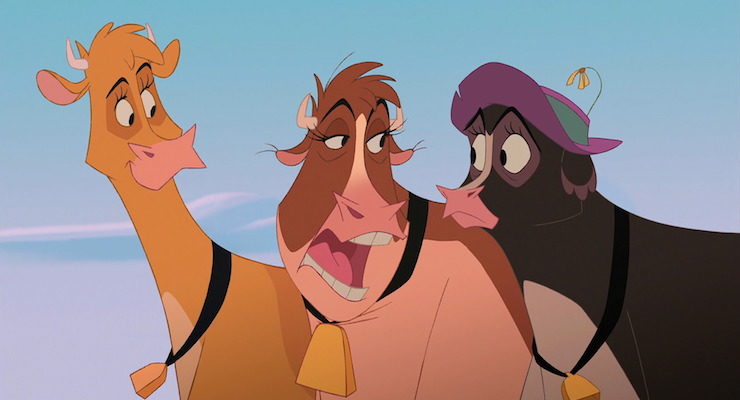“Ha! Bovine bounty hunters! Now I’ve seen everything.”
Sometimes, you’re sitting on a couch, aimlessly scratching the chin of an overly friendly cat, and then some animated bulls start sexually harassing an animated cow voiced by Judi Dench, and a cattle rustler voiced by Randy Quaid starts yodeling, turning the animated cows pink, and you start wondering where you went wrong in life.
And that’s all before Randy Quaid’s yodeling breaks into the William Tell Overture.
In the early 1990s, the Disney animation department was riding a new and unusual wave of excitement and cash, flush from the successes of The Little Mermaid and Beauty and the Beast. It was time, executives and animators alike agreed, for some new ideas, and artist and director Mike Gabriel, fresh from The Rescuers Down Under, where he had supervised the development of Disney’s new CAPS animation system, had one: a supernatural Wild West film.
Ghosts were mostly new to the animation studio, but Mickey’s Christmas Carol had done decently back in the day. Wild West shorts were not new to the studio, which had created several back in the 1940s and 1950s. None had exactly been a huge hit, but they continued to attract viewers when rebroadcast. It was enough for executives to agree to let Mike Gabriel start creating concept art for the new film, Sweating Bullets – once he’d finished work on the prestige feature Pocahontas.
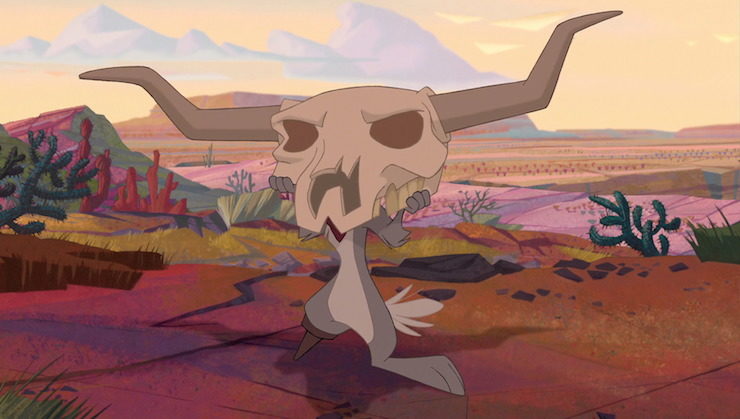
Unfortunately for Mike Gabriel, developing the story proved difficult, and the somewhat disappointing box office take for the much anticipated Pocahontas did not help his cause. In 2000, after making multiple changes to the story—including making the protagonist a bull named Bullets—he left the film. The project was handed over to Will Finn, now back with Disney after briefly following Jeffrey Katzenberg over to Dreamworks, where, among other things, he directed the successful The Road to El Dorado. Finn, who had worked with Disney throughout the 1980s and 1990s, knew most of the animators and Disney studio processes relatively well, and thought he could streamline this film into quick production. Executives also tapped John Sanford to help with the script and directing. It was the start of adding numerous storyboard artists and, eventually, six writers for the script, which probably contributed to the plot issues.
By that point, as mentioned in previous posts, Disney executives had a different problem on their hands: what type of animation to use. The Disney animated features had continued to do decently at the box office, but not to the levels of The Lion King. Worse, in recent years, they had been soundly defeated at the box office by films from a little company called Pixar—and Jeffrey Katzenberg, who had supervised the early days of the Disney Renaissance, was rapidly building up Dreamworks into another major rival. Both companies, Disney executives noted, were having tremendous success with something still relatively new: computer animation.
Despite their own reliance on computer animation for inking, coloring and special effects, and use of programs such as Deep Canvas to give the illusion of moving through a painting, Disney was not—quite—ready to completely give up the hand animated animation that had built the company in the first place, and more recently given it critical recognition throughout the Disney Renaissance. At the same time, it was difficult to ignore the financial success of Dreamworks and Pixar.
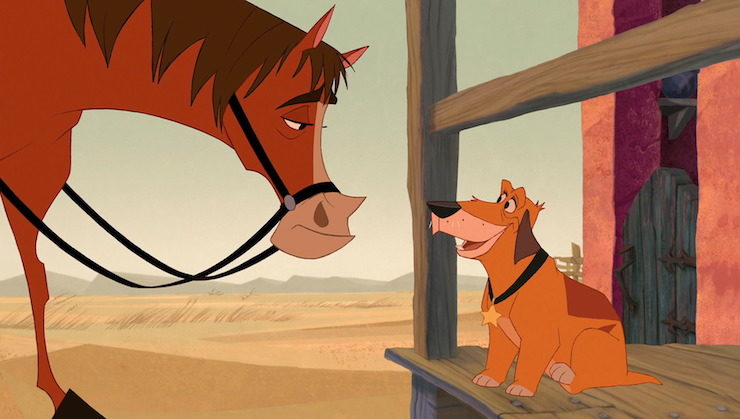
As Finn and Sanford reworked Sweating Bullets yet again, this knowledge hung over the studio. Still, Finn and Sanford decided to stick with hand drawn animation, and reworked the film yet again, splitting the main character, Bullet, into two characters, a bull called Junior and a horse called Buck. As they did, new disaster struck in the form of Treasure Planet, a financial disaster that led Disney executives to the decision to stop making hand animated films, and instead work with computer animation. The two films currently in production—including the Western film, now called Home on the Range—would be allowed to be completed, but after that, the studio would switch to computer animation.
Perhaps not surprisingly, this did not make the already slowed production on Home on the Range go any faster. Production, indeed, was so slow that Disney ended up shifting release dates, moving Brother Bear, a product of their Florida studio, into Home on the Range’s planned release spot. Animators still dawdled, until given an absolute last minute yes this will be released in April 2004 date we don’t care if you’re ready or not.
The delay stemmed from two separate, seemingly unavoidable issues: hand animating characters took time, and, given ongoing issues with the initial script, the main story had been changed yet again. The bull and the horse stayed around as largely minor characters, but the new story, directors decided, would focus on three cows and a yodeling cattle rancher. And since Disney did have money to spend on celebrity voice actors, somewhere along the line, someone got the bright idea of hiring both comedienne Roseanne Barr and Dame Judi Dench to voice two of the three cows.
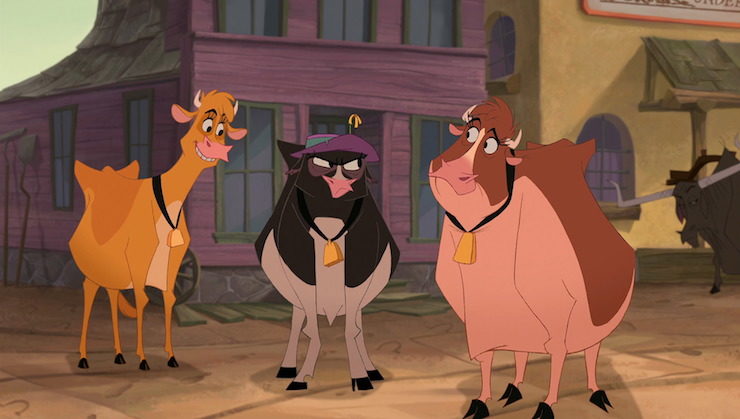
I should probably disclose at this point that I am not one of Roseanne Barr’s fans. To be fair, however, she’s hardly the worst part of the film, even if at all times she is clearly Roseanne Barr as a cow, only slightly toned down from her usual comic personality, right down to the mild vulgarity and occasional tasteless joke. Indeed, this film was immediately slammed with a PG rating and had to argue down a PG-13 rating, thanks to her opening joke about udders and a few later moments, though most of that and a later scene in a western saloon will go right over the heads of small viewers. And pairing her against Dame Judi Dench was almost an act of brilliance—with the “almost” more to do with the script than with either of the actresses. To play against them, Disney hired Jennifer Tilly to voice the third cow, filling out the rest of the cast with various celebrity voices and vocal talent including Cuba Gooding Jr., Steve Buscemi, and Randy Quaid as a yodeler.
And in a change from Disney’s usual habit of hiring one Top 40 performer for the nearly obligatory power ballad, Disney splurged on three Top 40 performers, hiring k.d. lang, Bonnie Raitt and Tim McGraw to perform three separate songs from a country-music/Western soundtrack written by Alan Menken, hired for a long term Disney contract after his success with several previous Disney films, with lyrics from Glenn Slater. If nothing here was quite as memorable as Menken’s earlier work for The Little Mermaid, Beauty and the Beast, and Aladdin, several of the songs at quite lovely. “Will the Sun Ever Shine Again,” sung by Bonnie Raitt, and reportedly written by Menken shortly after 9-11, is probably the musical highlight here.
Unfortunately, the music was one of the few highlights of the film, which otherwise, was mostly a mess. Quite possibly because of the endlessly changing storylines, directors, and release dates, or the overall pall lingering over the studio, Home on the Range struggles with dropped plot lines, confused character motivations, and some scenes that feel suspiciously like last minute additions meant to explain various things, which end up not really explaining any of those various things.
Take, for instance, the many issues with Roseanne Barr’s Maggie the cow. It’s not, as I noted, Roseanne Barr, but rather, Maggie’s confused and constantly ongoing shifting character motivations, which switch from altruistic to vengeful and back—when, that is, they aren’t completely forgotten.
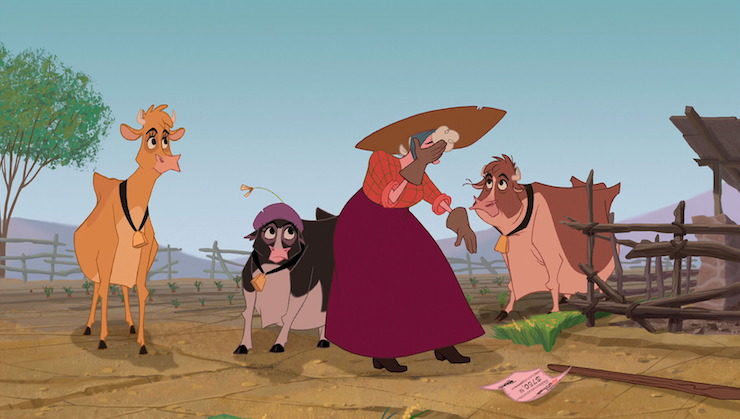
Her initial goal is clear: having already lost one home, she wants to save her new home, Patch of Heaven, currently threatened by bankruptcy if its owner, or her animals, can’t come up with $750 on the spot. Maggie comes up with a practical method of doing this: she and the other cows head off to a county fair to win money, something Maggie, a former prize cow, knows she can do. On the way, the cows find out that the sheriff just happens to have put out a $750 bounty—the exact amount the farm needs—on cattle rustler Alameda Slim, who just happens to be the very same cattle rustler that yodeled most of the herd away from Maggie’s former ranch, leaving her homeless. Maggie suggests going after Alameda Slim to get the bounty, which can save the farm.
A few scenes later, and Judi Dench—that is, Mrs. Calloway the cow—is claiming that Maggie’s intent from the beginning was vengeance, not saving the farm, and accuses Maggie of manipulating the other cows, even though, as viewers just saw, Maggie didn’t know that Alameda Slim was still around. Nor did Maggie even think of going after the cattle rustler until well after the cows had left their farm.
And yet, Maggie confesses that yes, vengeance has been her motive since the beginning, even though that can’t possibly be true.
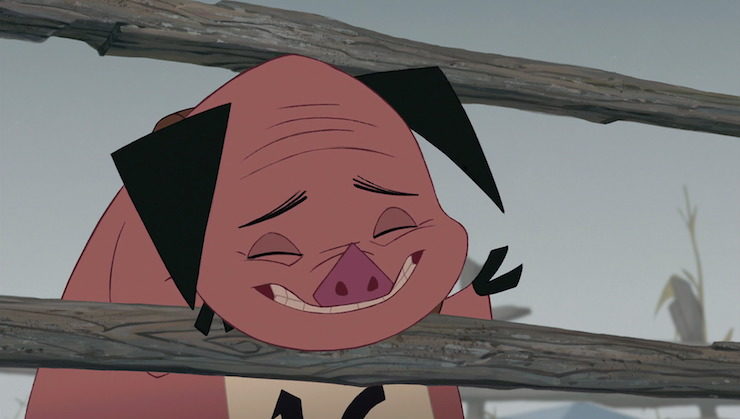
I can only assume that in an earlier script, Maggie was aware that Alameda Slim was still around, was seeking vengeance for her old ranch, and did manipulate the other two cows into helping her get her revenge—that is, until someone realized that a vengeful, manipulative cow was perhaps not the most sympathetic of characters. As a result, the entire plot of Maggie’s former ranch gets severely muddled, with several plot holes. For instance, how did Maggie—later shown to be fully susceptible to Alameda Slim’s yodeling, not get rustled away with the rest of the cows on her ranch in the first place? Why doesn’t Maggie recognize any of the cows hidden in the mine shafts by Alameda Slim and his incompetent goons, given that these are apparently cows from her own farm? Why don’t they recognize her?
And these are just the problems with Maggie. Other issues include dropped characters, the inexplicable decision to make Lucky Jack the Jackrabbit, among other things, a Native American shaman, the bulls who decide to sexually harass the cows—ok, yes, they are explicitly bulls, but still—the way the film suddenly introduces characters, then drops then, then several scenes later suddenly remembers that oh yes, the audience should be reminded about these characters, right (this is true both for Lucky Jack and for a number of the farm animals), several scenes that do nothing in particular, and oh yes, the yodeling.
To be fair, the yodeling is actually a plot point: it’s how Alameda Slim rustles cattle. His yodeling mesmerizes all nearby cows with perfect pitch—that is, all of the cows in the film except Maggie—turning him into a Pied Yodeller of sorts. It’s also just awful, especially when Randy Quaid—that is, Alameda Slim—starts yodeling various pieces of classical music, starting off a weird animation bit complete with dancing, eyes glazed over cows. The entire sequence is meant, I think, both to be a centerpiece of the film, and a throwback to Disney’s glory days, and in particular the pink elephant sequence in Dumbo. But love or hate Dumbo, at least no one in it tried to yodel any parts of Beethoven’s Ode to Joy.
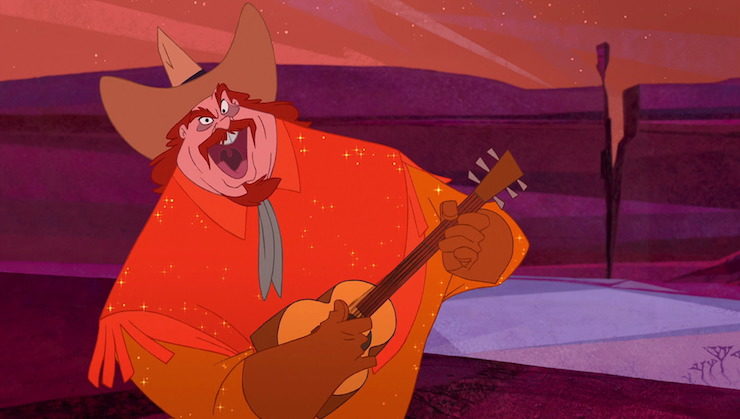
Randy Quaid, alas, does.
It’s topped by a later moment when crooked cattle dealer Wesley, voiced by Steve Buscemi, watches Alameda Slim and a rabbit roll down an old abandoned mine track, chased by a horse, chased by a buffalo, chased by some cows, chased by some goons yelling “UNCLE SLIM, UNCLE SLIM!” as Wagner’s Die Walkürie plays in the background, and Wesley says, “I gave up Clown College for this?” and I don’t think I have ever identified with Steve Buscemi as much before or since.
It’s Home on the Range in a nutshell: a film that often tries too hard to be funny, suddenly stops dead in the middle of the actual plot when it remembers that oh, yes, it does have other characters and should perhaps spend time on them, drops other plotlines, and has so many moments which ought to be great, but aren’t.
And oddly enough, although presented as a completely happy ending, the final moments are not exactly all that happy and satisfying, or for that matter, complete. Because, sure, the cows have managed to save Patch of Heaven, but apparently everyone, including Maggie, has forgotten the other farm—the Dixon Ranch, robbed at the beginning of the film, and still robbed and cowless at the end of the film. Sure, Maggie has her revenge and a new home—but what about all of the other cows and steers from that farm, not to mention poor Mr. Dixon, who still doesn’t have a ranch at the end of the film?
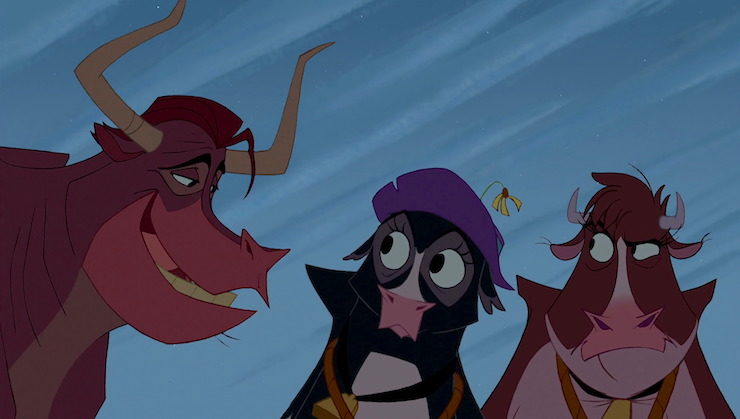
I also need to object to one minor note at the end: the bulls who earlier harassed Grace, Maggie, and Mrs. Calloway are not only completely forgiven for this, but end up dancing with the cows—joined by Junior the Buffalo, who had earlier chased them through an abandoned mine and nearly gotten them killed. I recognize that Disney likes to end its films with scenes showing everyone happily hanging out together, but in this case, it does seem a bit much, especially given Mrs. Calloway’s earlier clear disinterest in the bulls.
I need, however, to give Home on the Range credit for something still rare in full length Disney animated films: the decision to showcase several friendships between women. Not just between the cows, either: the chickens and geese have established firm friendships, and the women at the saloon don’t hesitate to unite to throw out some cows. (And one of those saloon women appears to be a cross-dresser, so kudos for that as well.) More than that, this is a film about three heroic women, who are trying to save their entire family from getting sold for food. The last time three heroic women stood up to defend themselves like this in a Disney animated film was back in Sleeping Beauty, and if I have issues with this film, I have to applaud it for at least this.

Audiences and critics did not applaud. The film was released in April 2004, the first time Disney had released a full length animated feature outside of their usual target seasons of summer or Christmas for decades. Years later, a similar release date would produce the blockbuster Zootopia, but no such fortune greeted Home on the Range. Whether it was the release date, or the rumors of vulgar humor, or something else is unclear, but after nearly fifteen years of work, Home on the Range did not even earn back its budget, bringing in only $103.9 million at the box office. Just twelve years later, Home on the Range DVDs were selling for just $5, well under the typical going rate for Disney films, and virtually all merchandise related to the film had vanished.
It was the final straw for Disney’s fabled yet beleaguered hand animation department. The studio would release only two more full length hand animated films, the 2009 The Princess and the Frog and the 2011 Winnie the Pooh. Instead, they focused on computer animated films.
Which brings us to Bolt, coming up next.
Mari Ness lives in central Florida.










